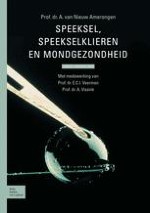2008 | OriginalPaper | Hoofdstuk
3 Vorming en secretie van speeksel
Auteur : Prof. dr. A. van Nieuw Amerongen
Gepubliceerd in: Speeksel, speekselklieren en mondgezondheid
Uitgeverij: Bohn Stafleu van Loghum
Samenvatting
-
Mondvloeistof (totaalspeeksel) bestaat voornamelijk uit een mengsel van klierspeeksels, waarvan SM-speeksel 30-70% en PAR-speeksel 0-60% uitmaakt, afhankelijk van het stimulatieniveau; PAL-speeksel levert onder stimulatie eveneens een substantiële bijdrage (5%); de overige kleine speekselkliertjes dragen samen voor ongeveer 7% bij aan mondvloeistof (zie verder hoofdstuk 4).
-
De secretoire cellen van de speekselklieren zijn grotendeels gevuld met secretiegranules; zij vormen een overcapaciteit, zodat bij gezonde personen de speekselsecretie gedurende de hele dag kan worden gestimuleerd.
-
De secretie van de PAR kan zowel door middel van kauwen als door smaakprikkels sterk worden gestimuleerd; de SM wordt minder door kauwen gestimuleerd, maar wel door middel van smaakprikkels, zoals zuur, zoet en menthol.
-
De muceuze secretie gaat in rusttoestand in een laag tempo continu door; de sereuze secretie moet echter altijd worden gestimuleerd.
-
De intracellulaire vertaling van de verschillende neuronale stimuli verloopt verschillend. Bèta-adrenerge stimulatie induceert de vorming van cAMP; alfa-adrenerge en cholinerge stimulatie induceren de vorming van diacylglycerol (DAG) en 1,4,5-inositoltrifosfaat (IP3) als second messengers, waardoor de intracellulaire [Ca2+] toeneemt.
-
Het primaire speeksel gelijkt in ionensamenstelling op bloedplasma; door resorptie in het afvoerkanaal worden Na+- en HCO3 --ionen geresorbeerd en K+-ionen gesecreteerd, resulterend in een hypotone mondvloeistof.
-
Stimulatie van de speekselsecretie bevordert de mondgezondheid door mechanische reiniging (spoeleffect, pH-verhoging en toename van de concentratie aan beschermende eiwitten.
